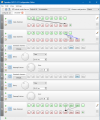I've been thinking about bass response in rooms, and a potential problem with equalization via IIR FIR filters, which may not address time delay issues correctly. For instance, a peak may be happening not because of a bounce that's one wavelength late, but may maybe two wavelengths. And a cancelation may occur from a bounce that's not half a wavelength delayed, but 1 and 1/2 wavelength delayed, or more. This got me concerned that just equalizing down a peak may cause sustained bass notes to end up with the correct level, but short notes to be too quiet, assuming a peak was equalized down. Plus, there's a chance that a delayed inverse signal may fix a null too.
So, I decided to turn off my extensive parametric equalization on my woofers and try to smooth things out using reflection cancelling by mixing in delayed, inversed, and attenuated signals. These are applied full bandwidth for the woofers, without any equalization. They're basically an inverted echo.
I got surprisingly good results with inverse signals delayed 20 ms and attenuated 11 dB, and another one delayed 40ms and attenuated 22 dB. I'm frankly shocked at how much those rather highly attenuated singals helped to smooth out the bass! The minus 22 dB made a difference! Apparently it all adds up in the room. It took some experimenting to discover how low the signal had to be for best results. This also cleaned up the spectrogram and improved clarity C50 and reduced early decay time. One weird thing is that making the spectrogram look cleanest did not necessarily equate to the smoothest response.
I end up adding two more delayed inverse signals - one at 7ms and 10 dB attenuated, and another at 10ms and 10 dB attenuated. These are all applied to my corner bass horns.
This is the best I've gotten the bass to sound in here so far, maybe the best I've had it in any room. Just four delayed inverse signals.
I put one parametric in for a problem spot at 150Hz that was audible and I couldn't figure out.
One thing I was hoping for was that I could also fix a problem with my bass horns where the sound gets stuck in the horn because of the folds ( I think ) at a certain frequency. It didn't totally fix that, but it reduced it by at least as much as I've ever managed with parametric filters. I'm currently limited to 1 ms intervals on the delay because of the software I'm using. Some .1 ms accuracy might be able to get after that sharp null from the horns better. Not sure about that.
So, I decided to turn off my extensive parametric equalization on my woofers and try to smooth things out using reflection cancelling by mixing in delayed, inversed, and attenuated signals. These are applied full bandwidth for the woofers, without any equalization. They're basically an inverted echo.
I got surprisingly good results with inverse signals delayed 20 ms and attenuated 11 dB, and another one delayed 40ms and attenuated 22 dB. I'm frankly shocked at how much those rather highly attenuated singals helped to smooth out the bass! The minus 22 dB made a difference! Apparently it all adds up in the room. It took some experimenting to discover how low the signal had to be for best results. This also cleaned up the spectrogram and improved clarity C50 and reduced early decay time. One weird thing is that making the spectrogram look cleanest did not necessarily equate to the smoothest response.
I end up adding two more delayed inverse signals - one at 7ms and 10 dB attenuated, and another at 10ms and 10 dB attenuated. These are all applied to my corner bass horns.
This is the best I've gotten the bass to sound in here so far, maybe the best I've had it in any room. Just four delayed inverse signals.
I put one parametric in for a problem spot at 150Hz that was audible and I couldn't figure out.
One thing I was hoping for was that I could also fix a problem with my bass horns where the sound gets stuck in the horn because of the folds ( I think ) at a certain frequency. It didn't totally fix that, but it reduced it by at least as much as I've ever managed with parametric filters. I'm currently limited to 1 ms intervals on the delay because of the software I'm using. Some .1 ms accuracy might be able to get after that sharp null from the horns better. Not sure about that.
Last edited:



